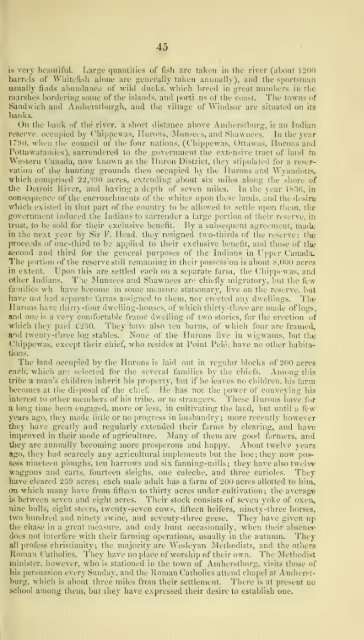Smith's Canadian gazetteer - ElectricCanadian.com
Smith's Canadian gazetteer - ElectricCanadian.com
Smith's Canadian gazetteer - ElectricCanadian.com
Create successful ePaper yourself
Turn your PDF publications into a flip-book with our unique Google optimized e-Paper software.
45<br />
is very beautiful. Large quantities of fish are taken in the river (about 1200<br />
barrels of Whitefish alone are generally taken annually), and the spoi-t.suian<br />
usually finds abumlanco of wild ducks, wliieh breed in great numbers in the<br />
marshes bordering some of the islands, and porti ns of the coast. The towns of<br />
Sandwich and Auiherstburgh, and the village of Windsor are situated on its<br />
banks.<br />
On the bank of the river, a .short distance above Ainherstburg, is an Indian<br />
reserve, occupied by Ohippewas, llurons, Munsecs, and Shawnecs. In the year<br />
1790, when the council of the four nations, (Chipi)ewas, Ottawas. Hurons and<br />
Pottawatauiies), surrendered to the government the extensive tract of land rn<br />
Western Canada, now known as the Huron District, they stipulated for a reservation<br />
of the hunting grounds then occupied by the Hurons and Wyandotts,<br />
which <strong>com</strong>prised 22,390 acres, extending about si.K miles along the shore of<br />
tJie Detroit River, and having a depth of seven miles. In the year 183fi, in<br />
consetpience of the encroachments of the whites upon these lands, and the desire<br />
wliich existed in that part of the country to be allowed to .settle upon tliem, the<br />
government induced the Indians to surrender a large portion of their reserve, in<br />
trust, to be sold for their exclusive benefit. By a subsequent agreement, made<br />
in the next year by Sir F. Head, they resigned two-thirds of the reserve: tlie<br />
proce^'ds of one-third to be applied to their exclusive benefit, and those of the<br />
second and third lor the general purposes of the Indians in U]iper Canada.<br />
The portion of the reserve still remaniing in their possession is about 8,000 acres<br />
in extent, lipon this are settled each on a separate farm, the Chippcwas, and<br />
other Indians. The ]Munsees and Shawnees are chiefly migratory, but the few<br />
families wh have be<strong>com</strong>e in some measure stationary, live on the reserve, but<br />
have not had separate farms a.'^signed to them, nor erected any dwellings. Tlie<br />
Hurons have thirty-four dwelling-houses, of which thirty-three are made of logs,<br />
and one is a ve'T <strong>com</strong>fortable frame dwelling of two stories, for the erection of<br />
which they paid ,£2.")0. They have also ten l)arns, of which four are framed,<br />
and twenty-three log stables. None of the Hurons live in wigwams, but tlie<br />
Chippewas, except their chief, who resides at Point Pele, have no other habitations.<br />
The land occupied by the Hurons is laid out in regular blocks of 200 acres<br />
each, which are selected for the several families by the chiefs. Among this<br />
tribe a man's children inherit his property, but if he leaves no children, his farm<br />
be<strong>com</strong>es at the disposal of the chief. He has not the power of conveying his<br />
interest to other members of his tribe, or to strangers. These Hurons have for<br />
a long time been engaged, more or less, in cultivating tlie land, but until a few<br />
years ago, they made little or no progress in husbandry ; more recently however<br />
tliey have greatly and regularly extended their farms by clearing, and have<br />
improved in their mode of agriculture. Many of them are good farmers, and<br />
they are annually be<strong>com</strong>ing more prosperous and happy.<br />
About twelve years<br />
ago, they had scarcely any agricultural implements but the hoe; they now possess<br />
nineteen ploughs, ten harrows and six fanning-mills; they have also twelve<br />
waggons and carts, fourteen sleighs, one caleche, and three carioles. They<br />
have cleared 2,'59 acres; each male adult has a farm of 200 acres allotted to him,<br />
on which many have from fifteen to thirty acres under cultivation; the average<br />
is between seven and eight acres. Their stock consists of seven yoke of oxen,<br />
nine bulls, eight steers, twenty-seven cows, fifteen heifers, ninety-three horses,<br />
two hundred and ninety swine, and seventy-three geese. They have given up<br />
tJie chase in a great measure, and oidy hunt occasionally, when their absence<br />
does not interfere with their fanning operations, usually in the autunm. They<br />
all profess Christianity; the majority are Wesleyan Methodists, and the others<br />
Roman Catholics. They have no place of worship of their own. The Methodis-t<br />
minister, however, who is stationed in the town of Amherstburg, visits those of<br />
his persuasion every Sunday, and the Roman Catholics attend chapel at Amherstburg,<br />
which is about three miles from their settlement, 'i'here is at present no<br />
school among them, but they have expressed their desire to establish one.

















